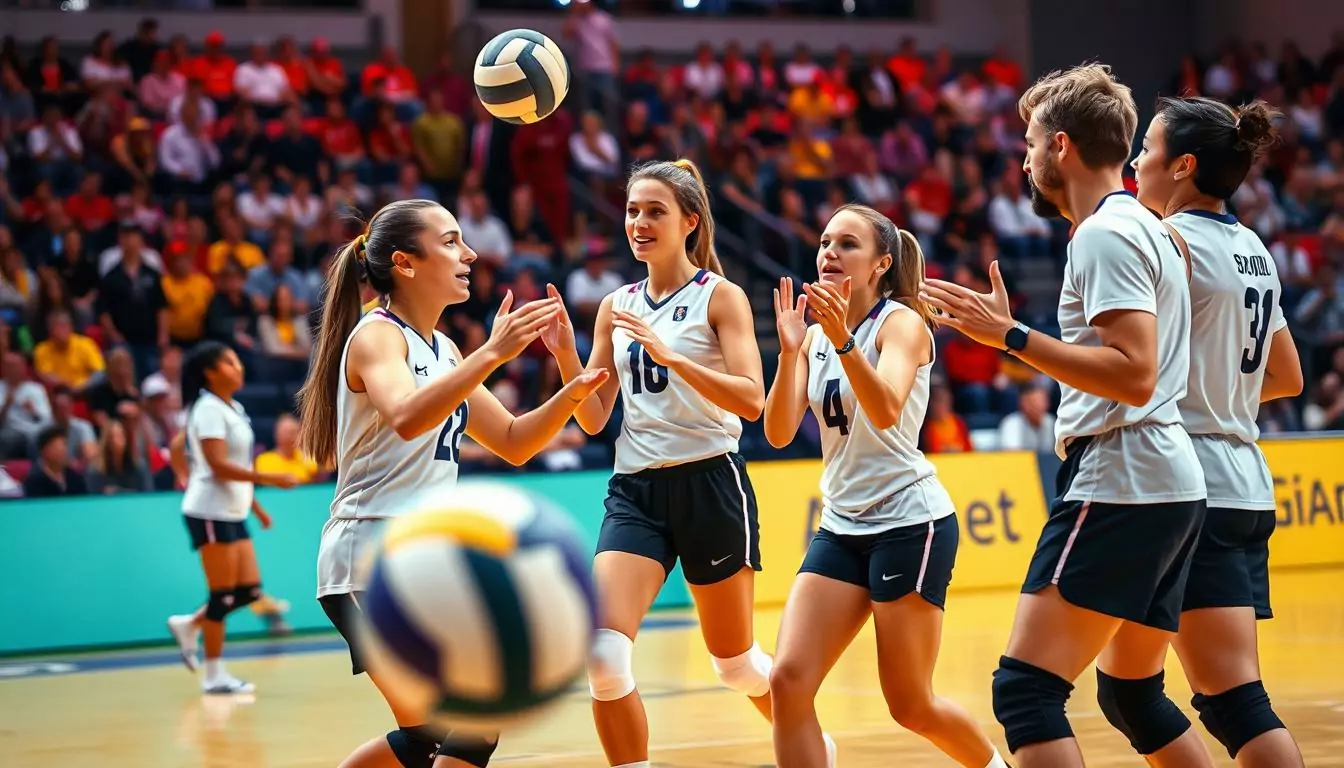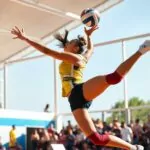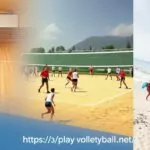Effective communication can profoundly impact volleyball games. It fosters team unity, helps read opponents, and anticipates court moves. This guide reveals secrets to mastering volleyball communication and boosting team performance.
Communication isn’t just about coordinating plays or giving instructions. It’s about creating a unified team dynamic. It’s about reading your opponents and anticipating every move on the court.
Key Takeaways
- Understand the fundamentals of verbal and non-verbal communication in volleyball
- Learn essential court calls and commands to enhance strategic planning
- Discover how to leverage non-verbal cues and hand signals for better coordination
- Explore strategies for building trust and emotional intelligence within your team
- Discover pre-game and time-out communication techniques to maximize performance
Understanding the Fundamentals of Volleyball Communication Skills
Good communication is vital for volleyball teams. Players must grasp verbal and nonverbal cues to excel on the court. Let’s explore how communication impacts team performance.
Verbal vs. Non-Verbal Communication Basics
Verbal communication in volleyball involves clear calls and instructions. This includes attack patterns, defensive strategies, and court positions. Active listening and quick responses are crucial.
Nonverbal communication uses body language and hand signals. These cues show team intentions and court awareness. Mastering these signals helps players react faster during games.
The Role of Communication in Team Success
Good communication builds trust and improves decision-making. It helps players anticipate game flow better. Clear messaging creates a strong foundation for success.
Poor communication leads to confusion and team breakdown. Prioritizing clear communication helps establish a winning mindset on and off the court.
Core Communication Principles for Volleyball
- Speak up: Communicate loudly and clearly, ensuring your teammates can hear and understand you.
- Be concise: Use short, precise language to convey your message, avoiding unnecessary chatter.
- Actively listen: Pay attention to your teammates’ cues and respond accordingly, demonstrating your engagement.
- Maintain positivity: Encourage and uplift your team through your words and tone, fostering a supportive environment.
- Adapt to the situation: Adjust your communication style based on the game’s pace, pressure, and your team’s needs.
These principles strengthen on-court team dynamics. They help teams work better together. Following these guidelines increases your chances of success.
Essential Court Calls and Commands Every Player Should Know
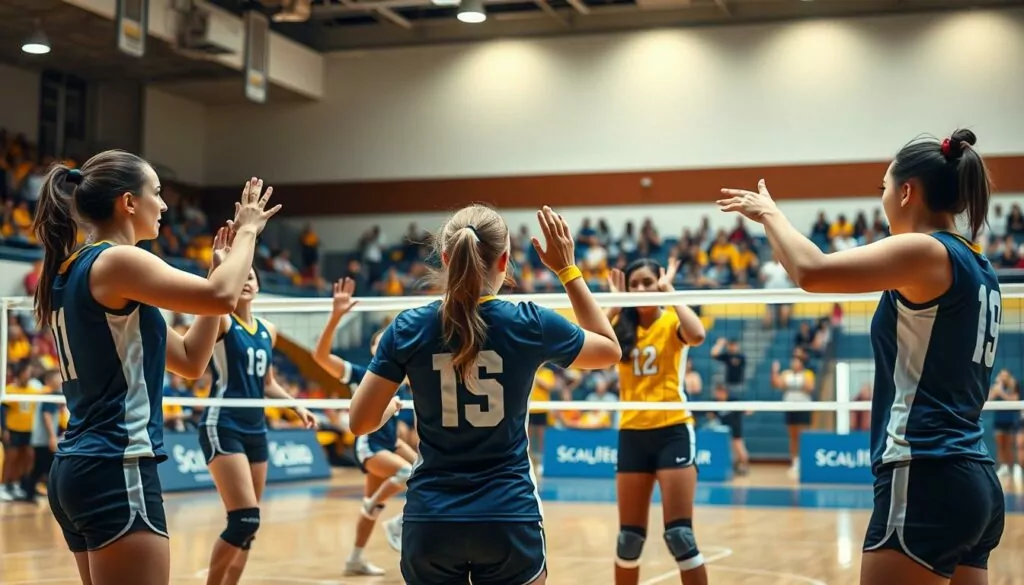
Strong volleyball communication skills are vital for successful team play. Mastering key court calls and commands helps with strategy and team coordination during matches.
Let’s explore the essential vocabulary every player needs for effective communication:
- “Mine!” – This urgent call alerts teammates that you’ll play the ball. It prevents collisions and ensures smooth ball handling.
- “Ball!” – This command informs teammates of the ball’s location. It helps them position themselves correctly.
- “Out!” – Signaling that the ball is out of bounds helps your team refocus. It prepares them for the next rally.
- “Free ball!” – This call indicates an easy ball from the opponents. It allows your team to plan an offensive attack.
- “Setter up!” – This cue alerts your setter to get ready. It helps with smooth transitions in your strategic planning.
Mastering these calls empowers you to communicate clearly with teammates. It enhances your team’s volleyball communication skills and contributes to overall success.
“Effective communication is the foundation of a strong, cohesive volleyball team. Every player must be on the same page to execute strategic plays and capitalize on opportunities.” – John Doe, Volleyball Coach
Mastering Nonverbal Cues and Hand Signals
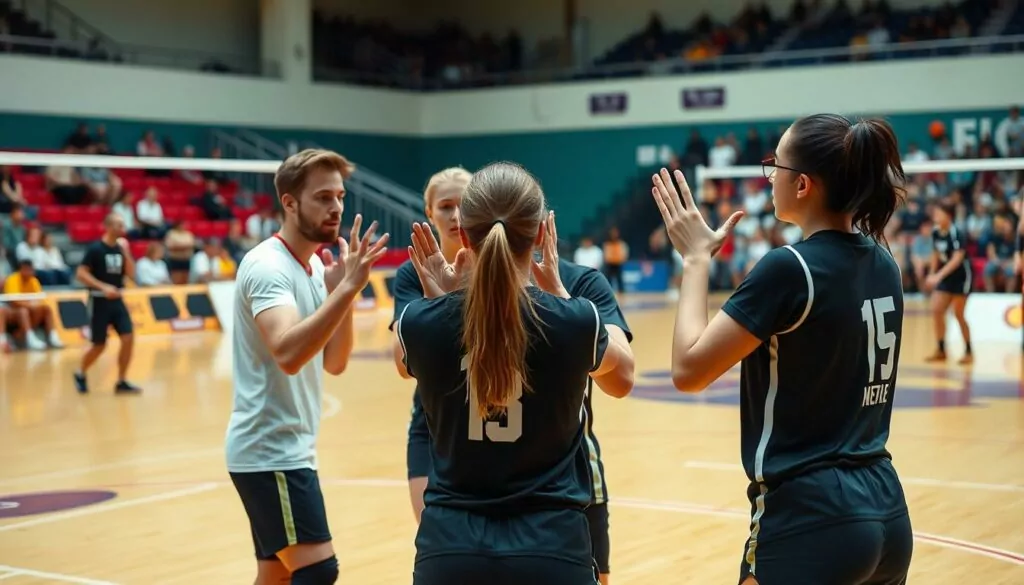
Communication is vital for volleyball success. Nonverbal cues and hand signals can give your team an edge. These subtle signals boost your team’s nonverbal cues and strategic planning.
Let’s explore how these signals can improve your game. They’re crucial for coordinating plays and staying ahead of opponents.
Pre-serve Positioning Signals
Pre-serve signals help align your team quickly. These gestures show where players should stand before the serve. They set up defensive or offensive plays silently.
Defensive Strategy Signals
Defensive signals keep your team in sync during rallies. They guide teammates’ movements to counter attacks. A simple sign can reposition your libero or middle blocker.
Attack Pattern Communications
Attack pattern signals are key for offense. They show hitting locations to hitters and setters. These cues help execute plays with precision.
Mastering these signals can surprise opponents. They improve your team’s timing and coordination on the court.
Incorporating nonverbal cues into your strategy is game-changing. Practice these tools to enhance your team’s planning and chemistry. You’ll see impressive results on the court.
Building Trust Through Effective Team Dynamics
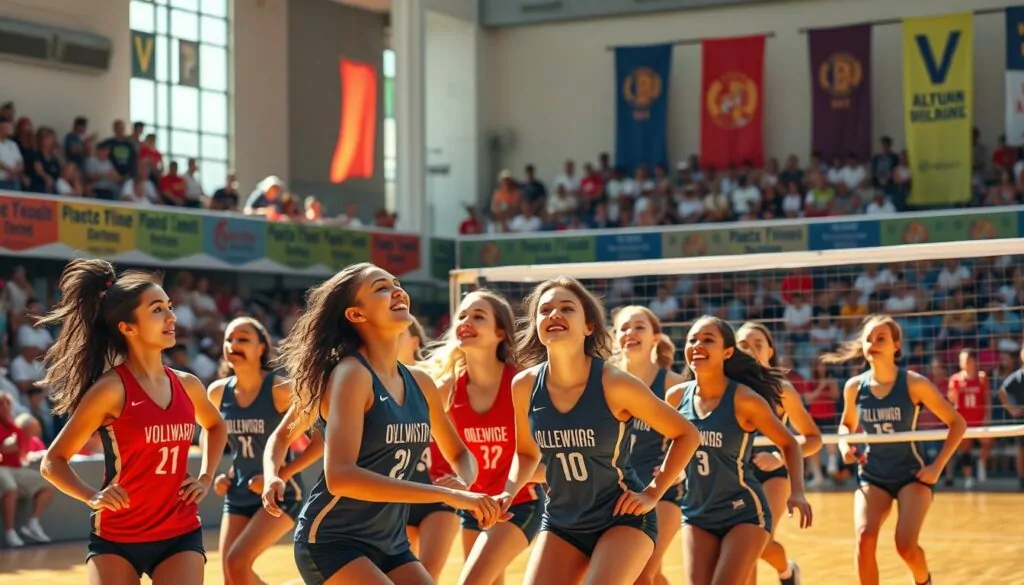
Trust and cohesion are vital for volleyball team success. Effective team dynamics boost communication and strategy. They also create a positive environment that brings out the best in players.
Strong leadership skills and emotional intelligence are key to building trust. These abilities help navigate team dynamics, resolve conflicts, and inspire teammates.
- Cultivate a shared vision and align team goals
- Encourage open and honest communication
- Provide constructive feedback and foster a growth mindset
- Develop empathy and emotional awareness
- Recognize and celebrate individual and team achievements
Prioritizing team dynamics creates a sense of belonging and trust. This empowers us to take risks and try new strategies. It also pushes us to reach new performance heights.
“The strength of the team is each individual member. The strength of each member is the team.” – Phil Jackson
A culture of respect, accountability, and camaraderie unlocks our team’s full potential. This leads to greater success on the volleyball court.
Developing Leadership and Emotional Intelligence on the Court
Strong leadership skills and emotional intelligence are vital for volleyball players. These abilities help create a united and driven team. They also enable players to handle tough situations and inspire teammates to excel.
Captain’s Communication Responsibilities
Team captains must do more than just call plays. They need to encourage open talks and listen to everyone’s ideas. Good captains use emotional intelligence to help players share their thoughts freely.
Managing Team Energy and Morale
Keeping team spirit high is key to success in volleyball. Leaders must sense the team’s mood and use motivational techniques to lift spirits. Your leadership skills can help the team stay strong in tough times.
Conflict Resolution Strategies
Conflicts will happen in any team. Leaders need emotional intelligence to handle these tricky situations. Good conflict resolution strategies help keep the team united. Listen to all sides and turn conflicts into chances for growth.
Using leadership and emotional intelligence in volleyball can boost your team’s performance. These skills help build a strong, motivated team ready for success.
“The true measure of a leader is not the number of people they manage, but the number of people they empower.” – John C. Maxwell
Pre-game and Time-out Communication Strategies
Effective communication is vital for volleyball teams during pre-game prep and time-outs. These moments allow coaches and leaders to reinforce strategies and boost team performance. They can showcase leadership skills and use motivational techniques to inspire the team.
Before the game, I gather the team to explain our plan clearly. I stress the importance of executing strategies well. I also remind my teammates of our hard work and dedication.
My goal is to inspire peak performance by creating a sense of unity and shared purpose.
Time-outs are perfect for making adjustments and giving feedback. I listen to my teammates’ concerns and observations carefully. Then, I explain any tactical changes briefly and constructively.
I use these moments to recharge the team’s energy and morale. I reinforce our determination to overcome challenges on the court.
